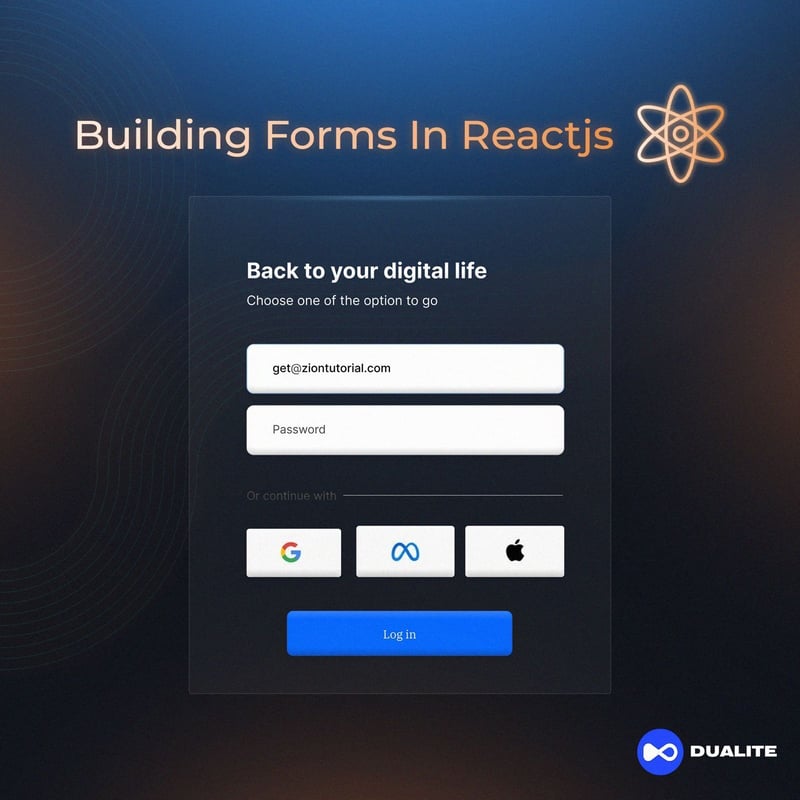

Forms are integral to web applications, enabling user interaction and data collection. In React.js, building forms involves using state management and component-driven architecture to ensure efficiency and maintainability. This guide will cover best practices for building forms in React.js, making your application robust and user-friendly.
Controlled components are the preferred way to handle form inputs in React. They keep form data in the component state, making it easier to manage and validate.
Store all the form input values in a state. Create an object and map all the input with their property in the state, Example below
import React, { useState } from 'react';
const MyForm = () => {
const [formData, setFormData] = useState({ name: '', email: '' });
const handleChange = (e) => {
const { name, value } = e.target;
setFormData({ ...formData, [name]: value });
};
const handleSubmit = (e) => {
e.preventDefault();
console.log(formData);
};
return (
<form onSubmit={handleSubmit}>
<input type="text" name="name" value={formData.name} onChange={handleChange} />
<input type="email" name="email" value={formData.email} onChange={handleChange} />
<button type="submit">Submit</button>
</form>
)}
export default MyForm
Error Handling and Validation is an important part of a form. You must validate and check for errors for every value entered by user and handle all the cases such as:
Must implement client-side validation to enhance user experience and reduce server load which eventually improves the performance. Utilize libraries like Yup or custom validation logic to ensure data integrity.
Lets see, how to implement custom validation logic
const validate = (formData) => {
const errors = {};
if (!formData.name) errors.name = 'Name is required';
if (!formData.email) errors.email = 'Email is required';
return errors;
};
const MyForm = () => {
const [formData, setFormData] = useState({ name: '', email: '' });
const [errors, setErrors] = useState({});
const handleSubmit = (e) => {
e.preventDefault();
const validationErrors = validate(formData);
if (Object.keys(validationErrors).length === 0) {
console.log(formData);
} else {
setErrors(validationErrors);
}
};
return (
<form onSubmit={handleSubmit}>
<input type="text" name="name" value={formData.name} onChange={handleChange} />
{errors.name && <span>{errors.name}</span>}
<input type="email" name="email" value={formData.email} onChange={handleChange} />
{errors.email && <span>{errors.email}</span>}
<button type="submit">Submit</button>
</form>
);
};
For ease of work, you must use Yup package to smoothly Validate the form data. It is a very popular package used with Form Libraries like React-Hook-Form or Formik.
Yup Docs: https://www.npmjs.com/package/yup
Libraries like Formik and React Hook Form simplify form management, offering powerful features out of the box and making easy for developers to build and validate forms in more scalable and flexible way
Using Formik:
Docs :- https://formik.org/docs/overview
import React from 'react';
import ReactDOM from 'react-dom';
import { Formik, Field, Form } from 'formik';
const BasicForm = () => (
<div>
<h1>Sign Up</h1>
<Formik
initialValues={{
firstName: '',
lastName: '',
email: '',
}}
onSubmit={async (values) => {
await new Promise((r) => setTimeout(r, 500));
alert(JSON.stringify(values, null, 2));
}}
>
<Form>
<label htmlFor="firstName">First Name</label>
<Field id="firstName" name="firstName" placeholder="Jane" />
<label htmlFor="lastName">Last Name</label>
<Field id="lastName" name="lastName" placeholder="Doe" />
<label htmlFor="email">Email</label>
<Field
id="email"
name="email"
placeholder="jane@acme.com"
type="email"
/>
<button type="submit">Submit</button>
</Form>
</Formik>
</div>
);
ReactDOM.render(<BasicForm />, document.getElementById('root'));
Click to check live Formik Demo
Building forms in React.js can be straightforward and efficient by following these best practices. Use controlled components for state management, validate inputs thoroughly, leverage third-party libraries, enhance UX with proper styling, and optimize performance to create responsive and robust forms.
By adhering to these guidelines, you can ensure your forms are reliable, user-friendly, and maintainable, providing a seamless experience for users and developers alike.
The above is the detailed content of Building Forms in React.js : A beginners guide. For more information, please follow other related articles on the PHP Chinese website!




